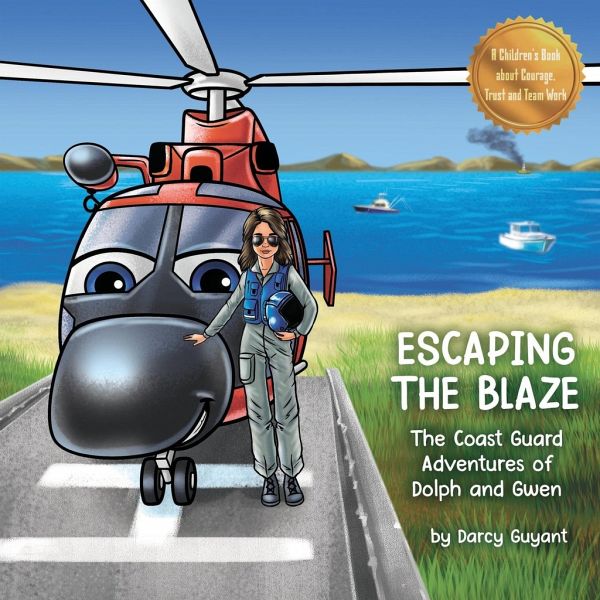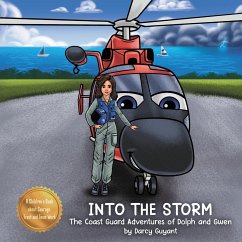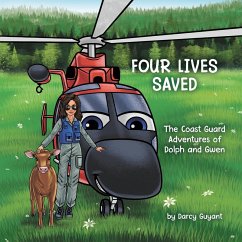
Escaping The Blaze
The Coast Guard Adventures of Dolph and Gwen

PAYBACK Punkte
7 °P sammeln!
Trapped! Two families are trapped by an approaching wild fire and need help escaping the blaze, fast! Dolph, a Coast Guard HH-65 "Dolphin" rescue helicopter and his pilot, Gwen, quickly respond to the urgent call of eight people needing rescue from an approaching fire. This mission is an unprecedented challenge for Dolph and Gwen, accustomed to water rescues. This mission will require unwavering courage, skilled teamwork, and trust. Two families, four adults and four children, are enjoying a stay at a remote 100-year-old Lightkeepers House, located at the end of a long narrow peninsula. Not fa...
Trapped! Two families are trapped by an approaching wild fire and need help escaping the blaze, fast! Dolph, a Coast Guard HH-65 "Dolphin" rescue helicopter and his pilot, Gwen, quickly respond to the urgent call of eight people needing rescue from an approaching fire. This mission is an unprecedented challenge for Dolph and Gwen, accustomed to water rescues. This mission will require unwavering courage, skilled teamwork, and trust. Two families, four adults and four children, are enjoying a stay at a remote 100-year-old Lightkeepers House, located at the end of a long narrow peninsula. Not far from their lodging, a strong wind has whipped a smoldering campfire into a grass-fire sending up a column of smoke. The smell of smoke is the first clue that something is amiss. An investigation of the source of the smoke revels a line of flames stretching the width of the peninsula moving toward them. High tides make escaping the fire along the beach impossible. They're trapped! Dolph, Gwen, the Rescue Swimmer (Sam) and the Flight Mech (Mike) must work together to accomplish this unusual rescue mission. Their courage and superb skills are rewarded in the end with a surprising discovery. This empowering story not only celebrates the bravery of Coast Guard heroes but also highlights the vital role of women in aviation. Gwen, a talented pilot, leads the charge to with confidence and expertise, showing young readers that women can excel in high-stakes, action-packed environments. Gwen symbolizes what it means to "fly like a girl." Illustrated with vibrant imagery that captures the thrill of flying, this story is a captivating read for children of all ages, especially those interested in airplanes, helicopters, how things work, the jobs they perform, and the people who fly them. The author, Mr. Darcy Guyant, is a retired U. S. Coast Guard HH65 Dolphin helicopter pilot. This story is an exciting true story based on a real-life rescue mission flown by Mr. Darcy and his crew in a Coast Guard Helicopter just like Dolph, but without eyes and a mouth, of course. This book also serves as a excellent introduction to STEM (science, technology, engineering and mathematics) lessons and discussions on the differences between airplanes and helicopters and how they fly. Lift Mechanism Airplanes relies on wings to generate lift by air flowing over the wings. Helicopters generate lift by rotating it's wings (rotor blades) very fast through the air. Forward Motion Airplanes are propelled forward by jets or propellers Helicopters can hover in place and move in any direction. Forward motion is achieved by tilting the rotor blades forward. Control Surfaces Airplanes employs control surfaces such as ailerons, elevators, and rudders to control roll, pitch, and yaw respectively. Helicopters utilizes cyclic, collective, and tail rotor controls. Speed and Altitude Airplanes are typically capable of higher speeds and altitudes due to its aerodynamic design and propulsion system. Helicopters generally, operates at lower speeds and altitudes but offers versatility in maneuverability and the ability to land and take off vertically. Runway Requirement Airplanes requires a runway for takeoff and landing due to its forward motion for lift. Helicopters can take off and land vertically, eliminating the need for a runway. It can operate in confined spaces and land in remote areas. Stability Airplanes are generally more stable in flight. Helicopters requires constant pilot input to maintain stability.












